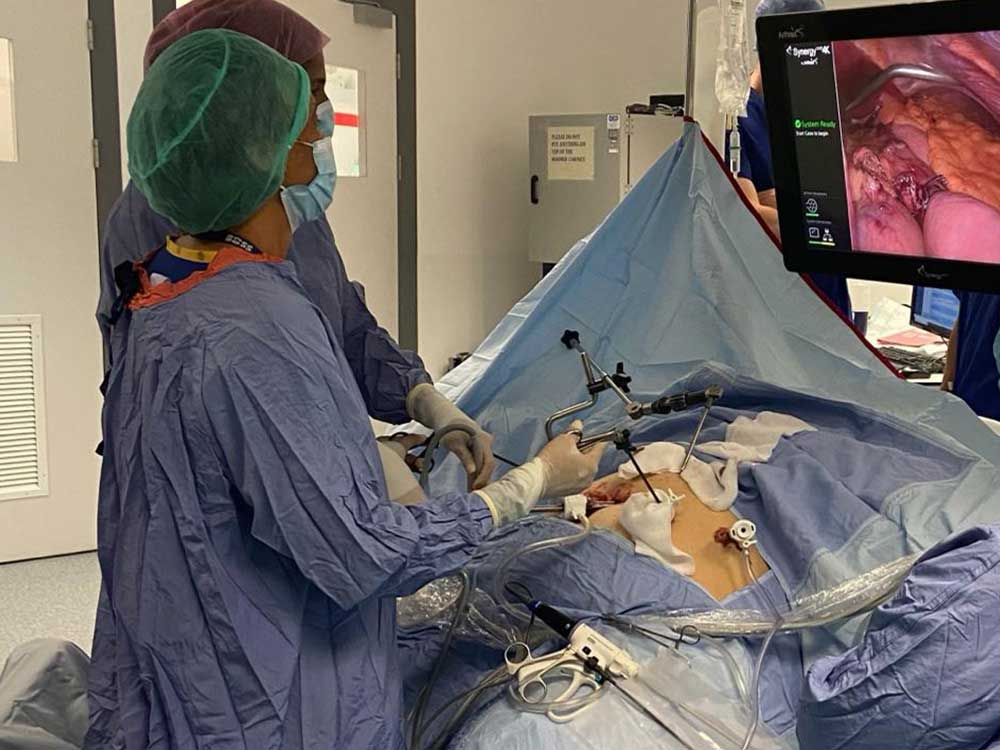Gastric balloon
Laparoscopic Hernia Surgery
The type of operation will depend on the type of hernia that you have. A brief overview is given below. There are now various different ways of repairing a hernia which will depend on many factors. For example, the type of hernia, the size of the hernia, your general health. Your surgeon will be able to discuss the type of operation with you in more detail.Inguinal hernia repair
This is usually done by a “key-hole” operation as the recovery is quicker compared to having an open operation. The operation is performed through three tiny cuts, the largest of which is only around 1.5 cm in size.
It is more common that inguinal hernias be repaired by using a mesh. This is a thin sheet of material which is usually stitched or glued over the hole of the hernia. This has been shown to be stronger and more effective than sewing the edges of the hole together for inguinal hernias. With time, the mesh safely becomes incorporated into the muscle layer, which results in a very strong, permanent repair.
Femoral hernia repair
As the hole through which a femoral hernia has to pass is very tight, there is a significant chance that any bowel that passes into it will become strangulated. This means that a femoral repair should be repaired early. Like inguinal hernias, femoral hernias are usually repaired using a mesh.Incisional hernia repair
Incisional hernias vary enormously in size which means that treatment may differ depending on the size of the incisional hernia. Again, a mesh is usually used, especially for larger hernias.Umbilical and paraumbilical hernia repair
Most umbilical hernias do not need repairing. Smaller hernias are usually repaired by an operation which simply closes the defect with stitches. However, umbilical and parumbilical hernias over 2 cm in length are usually repaired by using a mesh.
Newer techniques mean that people tend to be off work for much shorter periods than in the past. Even workers in heavy work can often be back in two weeks. The operation is usually very successful. However, hernias can recur in a small number of people, when a further operation may be advised.
Laparoscopic Hernia Surgery
The type of operation will depend on the type of hernia that you have. A brief overview is given below. There are now various different ways of repairing a hernia which will depend on many factors. For example, the type of hernia, the size of the hernia, your general health. Your surgeon will be able to discuss the type of operation with you in more detail.Inguinal hernia repair
This is usually done by a “key-hole” operation as the recovery is quicker compared to having an open operation. The operation is performed through three tiny cuts, the largest of which is only around 1.5 cm in size.
It is more common that inguinal hernias be repaired by using a mesh. This is a thin sheet of material which is usually stitched or glued over the hole of the hernia. This has been shown to be stronger and more effective than sewing the edges of the hole together for inguinal hernias. With time, the mesh safely becomes incorporated into the muscle layer, which results in a very strong, permanent repair.
Femoral hernia repair
As the hole through which a femoral hernia has to pass is very tight, there is a significant chance that any bowel that passes into it will become strangulated. This means that a femoral repair should be repaired early. Like inguinal hernias, femoral hernias are usually repaired using a mesh.Incisional hernia repair
Incisional hernias vary enormously in size which means that treatment may differ depending on the size of the incisional hernia. Again, a mesh is usually used, especially for larger hernias.Umbilical and paraumbilical hernia repair
Most umbilical hernias do not need repairing. Smaller hernias are usually repaired by an operation which simply closes the defect with stitches. However, umbilical and parumbilical hernias over 2 cm in length are usually repaired by using a mesh.
Newer techniques mean that people tend to be off work for much shorter periods than in the past. Even workers in heavy work can often be back in two weeks. The operation is usually very successful. However, hernias can recur in a small number of people, when a further operation may be advised.

